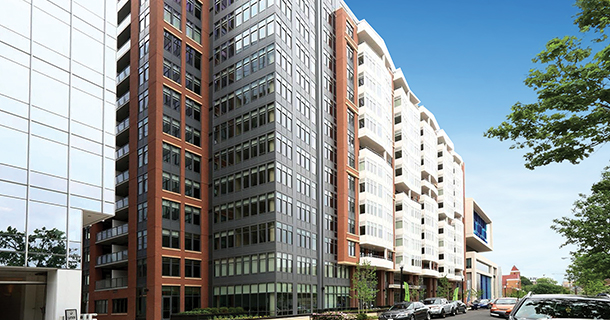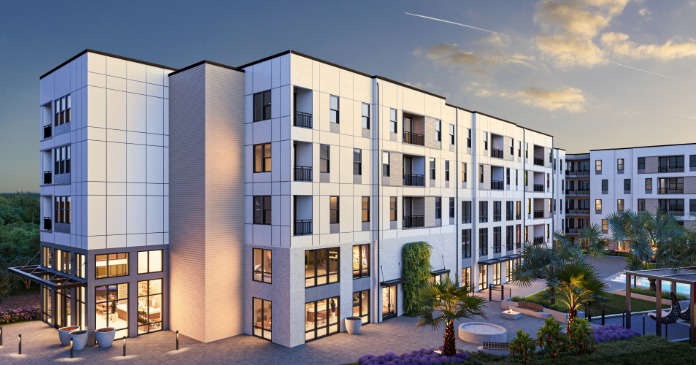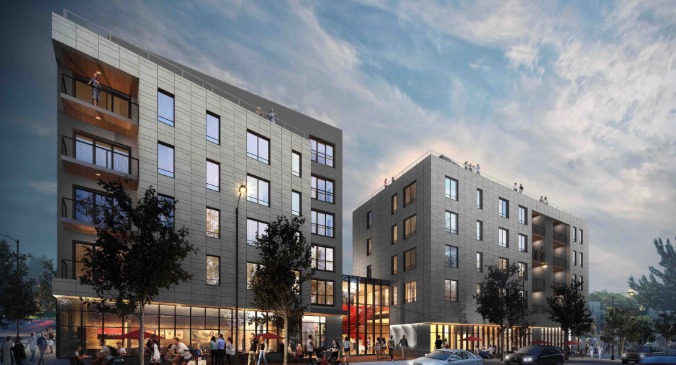“I love D.C.,” said Camden Property Trust CEO Ric Campo during the apartment REIT’s second quarter earnings conference call at the beginning of August.
“That’s why we have a big concentration there,” he said of Camden’s 19-property, 6,405-unit portfolio in the nation’s capitol, where the REIT recently completed construction of the $101.3 million, 321-unit first phase of transit-oriented Camden NoMa, which broke ground in Q4 2011. The $124 million, 405-unit second phase of the apartment community is scheduled to break ground in 2015 or 2016.
Although the U.S. government has had some hiring issues there, Campo considers the Mid-Atlantic region, which is home to two or three counties around D.C. that have a very high percentage of high-net-worth individuals and people with both graduate degrees and undergraduate degrees, an excellent long-term investment.
One of the more interesting aspects of the D.C. apartment market lately, he said, is that, despite challenging occupancy numbers and the lackluster job picture there, apartment asset prices haven’t changed much since the beginning of the market’s downslide a couple of quarters ago.
While it’s definitely one of the lowest growth or negative growth markets out there for some companies, he said, the value of Metro D.C. real estate continues to rise and there aren’t many bargains for those looking to buy multifamily assets, although he believes investors consider D.C. a great long-term market.
Camden saw negative year-over-year NOI growth of 0.4 percent in D.C. in Q2, although average rental rate for the REIT’s apartments there increased by 0.2 percent during the quarter and Camden’s D.C. portfolio was 96 percent occupied as of the end of June.
UDR, Inc.
UDR, Inc.’s Washington D.C. portfolio experienced slightly better results in Q2.
“Metro D.C., which represents 13 percent of our total NOI, had occupancy of 97.4 percent and effective rent growth of 90 basis points in the second quarter—a strong result considering the ongoing concerns many have for this market,” said UDR Sr. VP and COO Jerry Davis during the company’s Q2 2014 earnings call.
He attributed that encouraging result to the apartment REIT’s mix of approximately 40 percent Class A and 60 percent Class B product, as well as less direct submarket exposure to new supply.
“We believe these factors will continue to help us fare better than many of our peers in 2014. Our B assets in the market experienced revenue growth of 1.4 percent in 2Q, outperforming our A assets by 30 basis points. We are still expecting positive full-year revenue growth of approximately one percent in D.C.,” Davis said.
Expecting continued choppiness in the market for the next nine months to a year, Davis warned, “There’s more supply coming.”
Market watchers predict that the volume of apartment deliveries will increase to 18,000 apartments for 2014, following the completion of 10,580 units last year. “That construction will be heavily concentrated in the District and in the northern region of the metro. More than 2,000 units are slated for completion in the Central D.C. submarket, expanding inventory 4.6 percent this year,” Marcus & Millichap predicted recently.
Nonetheless, Davis is encouraged by the performance of UDR’s U Street assets, which include the 185-unit View 14, a 155,000-sq. ft. luxury condo-turned-rental property the REIT bought from D.C.-based Level 2 Development and Centrum Properties of Chicago for $104 million in June 2011, two years post-completion.
The sale of View 14 shattered the record for the highest price per foot ever achieved in the metro region for Class A rental product, at the time.
Located three blocks from the U Street Metro station, View 14, where rents range from $1,972 for a studio to two-bedroom units that start at $3,875, is performing slightly better than it did last year, Davis reported.
The nine-story, 255-unit Capitol View, developed by UDR and completed in 2013, includes 16,000 sq. ft. of retail space, a rooftop pool, a year-round outdoor fireplace, an open air kitchen and a courtyard Zen water garden feature.
Rents for the studio, one- and two-bedroom apartments at the community, which is located four blocks from the U Street Metro station, seven blocks from the Columbia Heights Metro and within easy walking distance of numerous restaurants, bars and shopping, range from $1,944 to more than $4,084.
“It’s interesting, when I look at D.C. and I look at the market rents compared to what they were a year ago, we’re about within one percent of where they were a year ago and they’re actually four percent higher than they were at year end,” said Davis.
There are submarkets, he said, that have been fairly stable, like Woodbridge and the District around Logan Circle. “But, again, whenever the new supply is going to come out of the ground, I think you’re still in for tough sledding,” he said.
However, UDR Sr. VP of Asset Management Harry Alcock said, “The truth is there is still a lot of demand for apartments in good D.C. locations and the pricing of recent trades reflects that. Buyers inevitably are going to contemplate that the next year or two is going to be flat in terms of revenue growth, but the good product still has plenty of buyer demand.”
According to Marcus & Millichap, D.C. metro transaction velocity grew 14 percent over the most recent 12-month period, with the largest increase in deal flow in the District, followed by Prince George’s County.
Median sales price was $178,200 per unit, with prices varying widely depending on location and asset quality. Buyers paid an average price of $148,200 per unit in the District, while Arlington County apartment communities sold for an average of $322,200 per unit.
Looking forward, the market research company predicted that investors will heavily target properties located in prime corridors like 14th Street and H Street, while buyers looking for higher yields will likely focus on value-add opportunities in transitional areas east of the Anacostia River.
Equity Residential
Equity Residential, which owns and manages 17,553 apartment units in the Washington D.C. Metro, reported slightly less happy news regarding the company’s biggest market. In the struggling market that produced 18.4 percent of the apartment REIT’s NOI year-over-year as of the end of June, revenues slipped 0.7 percent, as NOI declined by two percent, the average rental rate for the REIT’s apartments decreased by 0.5 percent and occupancy saw a 0.2 percent dip.
The disappointing numbers reflect the equally disappointing job growth over the past year or so in D.C., where the employment market suffered last year thanks to federal spending cuts and uncertainty in the market that saw creation of just 22,600 new jobs. This year local employers are expected to generate around 32,000 jobs, expanding payrolls around one percent.
However, those disappointing results were not unexpected, Equity Residential’s COO and EVP David Santee said at the end of July. “With lackluster job growth and outsized supply, positive revenue growth for the metro area continues to be elusive, although net effective base rents across all of our eight submarkets can be up two percent one week and down two percent the next.”
He’s pleased with the REIT’s 94.9 percent occupancy rate in the District, which is a mere 0.5 percent less than the average occupancy rate for the company’s total 100,648-unit coast-to-coast portfolio.
“Occupancy and current exposure are all favorable, as demand for quality apartments in great locations remains steady and our current residents are staying put, as move-outs for the first half of the year are down more than 400 basis points, while we continue to achieve renewal increases above three percent,” Santee said.
“For D.C. metro submarkets, the Maryland suburbs lead the way. Year-to-date, Prince George’s County and the I-270 corridor continue to enjoy positive revenue growth, while South Arlington and Alexandria bring up the rear at minus 2.2 percent and 1.56 percent, respectively. Our District portfolio is negative 58 basis points year-to-date, but August billings are positive 11 basis points versus last August,” he reported.
He maintained a positive outlook at the end of July on the market where around 60 percent of the expected 20,000 apartments had delivered by mid-year.
“When I look at our billings today, we are, for the month, minus 10 basis points. So, we’re seeing better occupancy. We are seeing the net effective base rents stabilize—I guess I would say that I’m very pleased with how D.C. is behaving. And, if the next six months are like the last six months, then I think we’re setting the stage for some reasonably stable performance,” he said.
But, he’s not ready to dive into any acquisitions there quite yet. Asked if the company is looking to add assets in the D.C. market, CEO David Neithercut said that he’s seen a small amount of transaction activity in D.C., mostly focused on deals that traded before any lease-up occurred to avoid TOPA transaction issues.
According to the District of Columbia’s Rental Housing Conversion and Sale Act of 1980, before the owner of a tenant-occupied housing accommodation can sell that accommodation, the owner must first provide the tenant or tenants with the opportunity to purchase that residence, meaning that owners of residential property in D.C., who rent the property to tenants, own their real estate subject to those TOPA rights.
Under TOPA, prior to the sale of a housing accommodation, the owner must send, by first class mail, a bona fide written offer of sale to each tenant and the mayor of the District of Columbia, including the asking price, a statement that the tenant has the right to purchase the accommodation and material terms of the sale.
And, while things are going reasonably well in D.C., given the supply issues, Neithercut isn’t seeing a great deal of transaction activity at prices Equity Residential would consider opportunistic.
On the development side in D.C., Santee said he’s starting to see apartment building move back out to Reston and outside the Beltway, beginning next year and beyond. As with Boston, Neithercut said, development is increasingly shifting towards the suburbs in D.C.
The REIT’s execs also are pleased with D.C. portfolio rent increases. “I quoted the renewal rate at 5.5 percent versus the new lease rates,” Santee said, explaining that he expects to see that rate of increase drift down going forward in the company’s continuing effort to minimize expirations in Q4.
In a place like D.C., he said, Equity Residential probably will be a little more defensive in maintaining that occupancy, preparing for another onslaught of deliveries next year.
“The stronger we can maintain occupancy in a market that’s delivering units, the more pricing power and the less susceptible we are to having to give concessions—So, that will be our strategy in that market,” said Santee, adding that he expects D.C. rents will be four percent above last year’s by Q4 of this year.
AvalonBay Communities
AvalonBay Communities, which owned or held a direct or indirect ownership in 82,384 apartments in 275 communities in 11 states as of June 30, saw a year-over-year decrease in Q2 of 2.1 percent in Mid-Atlantic region rental revenues, which were flat sequentially in the bi-coastal apartment REIT’s weakest performing region during the quarter.
“The performance of our Metro D.C. portfolio was negatively affected by the addition of several former Archstone communities in Northern Virginia and Washington, D.C. to the same-store portfolio,” CEO Tim Naughton and CFO Kevin O’Shea explained in the company’s Q2 2014 management letter, referring to the REIT’s purchase of some 22,000 apartment units when AvalonBay and Equity Residential bought the Archstone portfolio last year.
“Metro D.C. will remain challenged, with completions totaling almost seven percent of stock during ‘14 and ‘15, with only modest job growth projected over this time frame,” Naughton said, during the REIT’s Q2 2014 earnings call, noting that market performance varies and market leadership does rotate over time.
“I think Northern California and the Mid-Atlantic are perhaps two of the best examples of markets that we’ve been active in for a long time. They’re both strong markets and they’ve outperformed for a long period, in this case 15 years. But, importantly, they don’t move together or necessarily in the same way over the course of the cycle, which we think provides healthy diversification and helps smooth our overall growth profile,” he said.
Both the Northern Virginia and D.C. markets have been impacted by weak job growth and new supply exceeding three percent of existing inventory, Naughton and O’Shea said in their letter, adding that, over the near term, some 1,500 to 2,000 apartments per quarter are projected to be delivered into each market, with Northern Virginia deliveries peaking in 3Q 2014 and Washington D.C. deliveries peaking sometime in 2015.
Year-over-year comparisons indicate that while AvalonBay’s portfolio-wide average rental rates increased 3.2 percent, they declined 1.6 percent in the Mid-Atlantic, where occupancy was down 0.5 percent and NOI declined 6.7 percent from a year earlier in the apartment REIT’s 7,950-unit D.C. portfolio.
“With few industries adding jobs in the region and the expectation for new apartment supply to remain elevated over the near term, we believe the Mid-Atlantic region will face a challenging operating environment through 2015,” the executive duo predicted.
With the outperformance of AvalonBay’s 2,894-unit San Francisco portfolio that saw a 6.1 percent increase in rental rates in Q2, compared to an average increase in rental rates of 3.2 percent portfolio-wide, analysts wondered, during the Q2 call, when the REIT might begin selling some of those Northern California outperformers and recycle the profits into the D.C. market in early-stage trades before things start to turn in the opposite direction.
“Absolutely,” answered Naughton, “We were pretty big sellers in the Mid-Atlantic two or three years ago. And, I think we have to remind ourselves that the underperformance in D.C. has been two quarters now and we’ve been talking about it coming for about two-and-a-half or three years. As an industry, we could just see the supply kind of coming through the system.”
“Obviously, we tried to take advantage of that a couple of years ago in terms of selling, but we’ll look to take advantage of it on the buy side, as well,” the CEO predicted.
And AvalonBay’s EVP of Investments and Asset Management Sean Breslin added, “We sold probably around $400 million in assets in D.C. over the last two or three years, knowing kind of the current environment was coming,” he said, adding that, while he isn’t seeing opportunistic acquisition options that pencil right now, there hopefully will be a window at some point where pricing and sellers’ expectations change in D.C., providing a good entry point.
Another trend that is emerging in AvalonBay’s markets is the outperformance of the suburban submarkets, Naughton said. “It’s something we’ve been projecting, given the concentration of starts and deliveries in our urban submarkets, a trend that should persist for the next couple of years as urban deliveries are expected to deliver more than two times the rate of suburban submarkets over the next two-and-a-half years,” he said.
“This is, I think, just another example where our exposure to both urban and suburban submarkets provides us additional diversification over the course of the cycle,” said Naughton.














